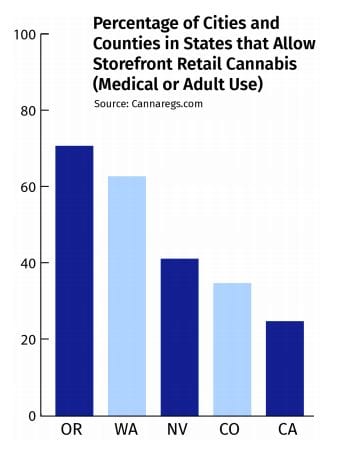 A review of 42 scientific studies conducted by Leafly.com has found that the broad body of published research suggests crime near licensed dispensaries has generally stayed flat or decreased, teen cannabis use in legalization states has fallen since legalization, and property values near cannabis outlets generally are not affected or even rise.
A review of 42 scientific studies conducted by Leafly.com has found that the broad body of published research suggests crime near licensed dispensaries has generally stayed flat or decreased, teen cannabis use in legalization states has fallen since legalization, and property values near cannabis outlets generally are not affected or even rise.
Leafly editors David Downs and Bruce Barcott worked with cannabis policy expert Dominic Corva, co-director of the Humboldt Institute for Interdisciplinary Marijuana Research (HIIMR) at Humboldt State University in Arcata, CA on the study.
Leafly has shared the literature review, “Debunking Dispensary Myths,” with elected officials, legislative aides, activists, industry groups, and researchers nationwide, as well as presenting the findings at upcoming events.
The study authors found that as of May 1, 2019, California leads the pack in the percentage of local jurisdictions banning cannabis stores:
• In California, 75% of jurisdictions have banned cannabis stores.
• In Colorado, 65% of cities and counties have similar bans.
• In Massachusetts, 54% of the state’s 351 municipalities have banned cannabis stores.
• In Washington, 35% of cities and 20% of counties have banned cannabis stores.
• In Nevada, 75% of counties and 42% of cities prohibit cannabis stores.
Cited among local concerns is a 2019 LA Times story, “Marijuana Production Faces ‘War’ From Asian American Communities.” That scenario has just played out in Mountain View, among other cities. The extreme situation in California has lead Assemblyman Phil Ting, himself an Asian-American, to introduce AB 1356, a bill which would require localities where a majority have voted in favor of cannabis legalization to license a certain number of retail outlets. (UPDATE 5/30 – Assemblyman Ting could not muster the two-thirds vote of the Assembly required to alter the voter-approved initiative to prevent cities and counties from banning pot shops. Read more. )
Clean Stores, Good Neighbors
At the state level, the most-cited studies suggest crime stays flat or goes down amid a store opening, the study states. An overwhelming majority of the studies available found no increase in crime related to the location of dispensaries or stores.
An overwhelming majority of studies—including one from the journal Preventive Medicine in 2018, and a Federal Reserve Bank 2017 paper—found no increase in crime related to the location of medical marijuana dispensaries or adult-use retail stores.
In Colorado and Washington, where data is now available from five years of adult-use cannabis sales, many local officials have switched from hesitance to confidence in the positive benefits of well-regulated stores. Cannabis companies “are tremendous employers and socially responsible members of the communities in which they operate,” said Ron Kammerzell, former senior director of enforcement at the Colorado Dept. of Revenue.
A study of California counties found “a negative and significant relationship between dispensary allowances and property crime rates, although event studies indicate these effects may be a result of pre-existing trends.” (Hunt, 2018 ).
Also see: Cal NORML: Do Medical Marijuana Dispensaries Increase Crime? and NORML Fact Sheet: Marijuana Regulation and Crime Rates
Teen use unaffected specifically, declines generally
Teen use—as shown by more than a dozen papers and national self-reported youth health surveys—is not directly impacted by the opening of cannabis dispensaries, the study concludes.
Colorado and Oregon state health reports show teen cannabis use is flat or down since licensed adult-use stores opened. In Washington, a 2018 JAMA Pediatrics study concluded use had fallen. Federally administered surveys show the 2016 teen use rate was the lowest in more than 20 years.
In California, the most current, in-depth, independent survey data show cannabis use among seventh grade students dropped 47% from 2013 to 2017. Hundreds of medical cannabis dispensaries operated during that period.
Also see: Student/Youth Usage Studies in California
Property values increase
A 2016 study in the journal Economic Inquiry concluded allowing stores added 6% to city home prices, compared to ban towns. A 2018 study in the journal Contemporary Economic Policy found home prices went up by 7.7% within a half-mile of a new cannabis store.
Know Your Science
A discussion of each topic in the study includes theories about what might be driving the results, and possible avenues for future study. An appendix lists the studies reviewed, color coded as green (positive), yellow (neutral) and red (negative). Green predominates. An extended bibliography and information for policy makers is included.
Often it is said by officials, “I could show you a stack of studies on either side.” To which our response should be, “Oh, but our stack is so much taller, despite a persistent attempt to fund only negative studies.” In a political environment where decisions are more and more made on a “gut” or emotional level rather than a rational one, it’s important nonetheless to know and talk about the science as we work towards better policies.
